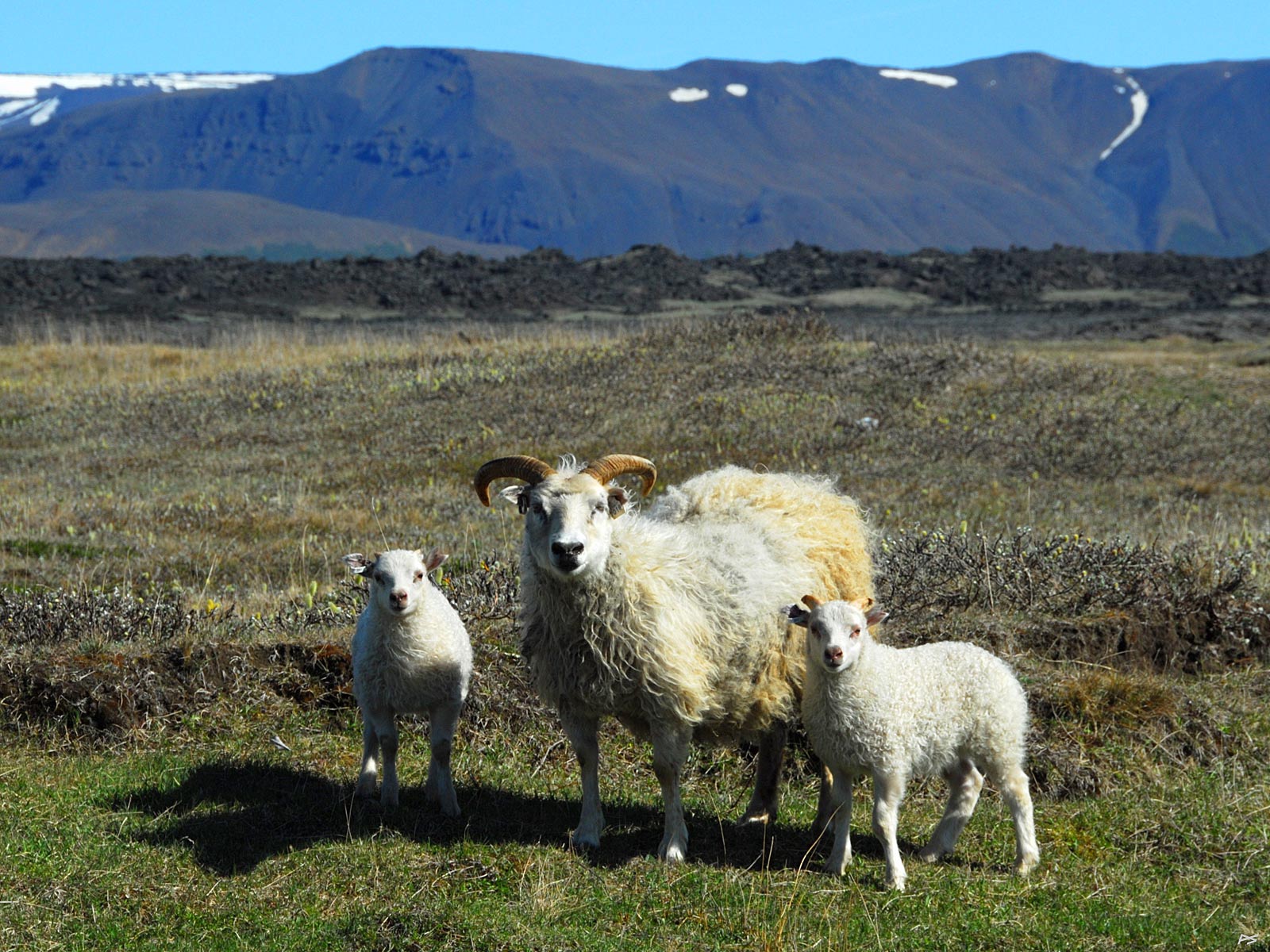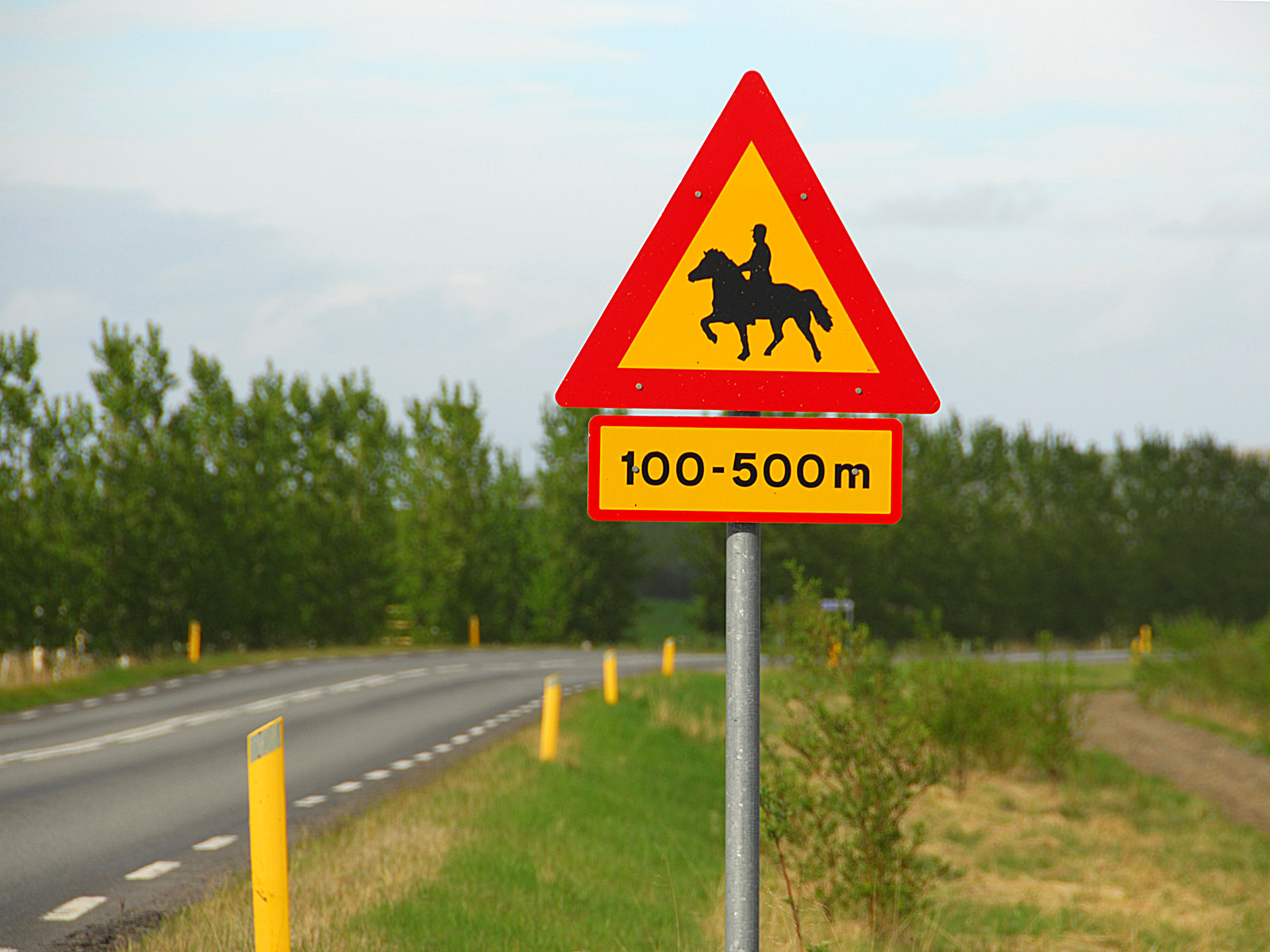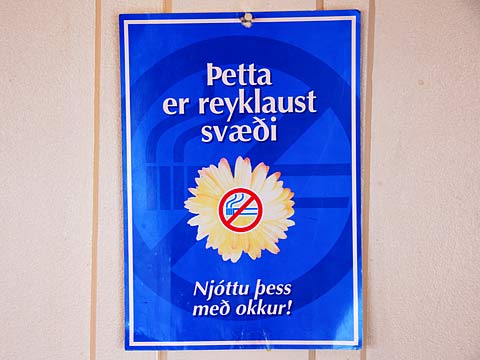Like other old countries,
this island has its own food traditions,
but you may of course order pizza

(2010-06-06)
The Iceland sheep are of the Northern European short-tailed sheep breed, brought there by the settlers. Most of them are horned. (Mývatn area)
A part of the old Icelanders were fishers, eating mainly fish and sea mammals. A larger fraction of the Icelanders was farmers. Their main source of food was sheep, but they had dairy products and grains were grown. When the settlers arrived, the climate was relatively mild, but later on it became progressively colder until the "Little Ice Age" lasting roughly 1350–1850. After year 1900 the average temperature increased again.
Today export of fish and fish products are important contributions to the economy. Farmers still supply the home market with meat, chiefly meat and dairy products. In greenhouses heated by geothermal water and illuminated by cheap electricity, tomatoes, cucumber etc. are produced. But cereals are mostly imported. So what can we expect visiting Icelandic restaurants?
Icelandic lamb is special. It's a thousand years old race and the pastures are special. Maybe it's the latter, but I don't know the exact secret of the great taste.
Next in line – or maybe first in line – come all kinds of fish; like cod, halibut, arctic char and salmon caught in the wild. (The latter is much better than farmed salmon.)

(2010-06-07)
Illustration from the great Héraðsvötn (Skagafjörður) river delta.
Then let's proceed to the special foods, some traditional, some controversial, and some tasting bad to many tourists:
You may sometimes be offered horse meat in restaurants. It's tasty, maybe slightly sweetish. Many horses are raised for meat and some are exported to Japan. Unfortunately this is taboo food for a lot of people.
There are wild reindeer in the north of the country, once brought here from Norway. This might also be taboo food for some Americans (can't eat Rudolph), but it is very tasteful for those who likes the taste of the wild.
Whale meat is also controversial, but forget that, just enjoy it!
Also, the Icelanders really know how to smoke meat and fish, like nobody else. The smoke may come from slowly burning birch, willow etc., but the special and strong favour comes from burning - oh, you might not want to know, so you may skip the rest of this paragraph. They sweep up dung, dried urine, straws and whatever has accumulated on the floor of the sheep pen and dry it, then burn it in the smokehouse. In spite of what it sounds, there is nothing unhygienic about it, and the result is marvellous. I suppose they started to use the latter method because shrubs are scarce.
Do you know the (Atlantic) puffins (Fratercula arctica), also called sea parrots? Icelanders eat them and you can get them in restaurants, but if you're hungry, select another dish.
One of the most tasty dishes I found in this country was hverabraud (=hot-spring-bread) with creamed butter and smoked Arctic char. Hverabraud is rye bread cooked at 100°C for 12–24 hours in a box buried close to a hot spring.
Like some other Scandinavian countries Iceland has its fermented fish tradition. Sweden has its surströmming (fermented Baltic Sea herring), Norway has its rakørret (fermented freshwater trout), and Iceland has its hákarl (fermented Greenland shark). In each countries it's now special feast food, and it's usually served with beer and schnapps (although many Swedes say they prefer milk with surströmming). In contrast to the Swedish and Norwegian tradition, which were means of conserving the fish, the Greenland shark was buried in the beach sand to ferment to make it edible for humans.
What I haven't tried yet is the ammonia etc. reeking kæst skata (skate having been buried and fermented), served with potatoes and rancid sheep fat on Þorláksmessa (St. Thorlakur's Day) 23 December. To save the indoor olfactory environment for Christmas, the party often take place in a shed or garage.

(2010-06-03)

I'd better stress, Icelandic horses are usually not kept for food. They are used for riding, by farmers e.g. for rounding up sheep, and by a lot of people for leisure and sport. Many of these horses can perform one or two extra gaits, the most impressive one I think is the tölt; a rider seems to be gliding along, even in rough terrain. To keep the horses free of the common diseases, no horses or horse equipment (without disinfection) are allow to enter Iceland. Those horses are also very popular abroad and many are exported; unfortunately they are not immune to the common diseases.

(2010-06-03)
| Vetur = Winter | Sumar = Summer | |
| Mánnudagur = Monday | Fimmtudagur = Thursday | |
| Föstudagur = Friday | Laugardagur = Saturday | |
| Lokað = closed |
In Iceland booze and strong beer (above 2.25 percent alcohol) can be bought only in restaurants and bars, and in the government shops called Vínbúðin. Because this is a "big" town (Höfn, 1800 inhabitants!) the opening hours are quite long. Although all kinds of liquor are available, the traditional kind must be mentioned: Brennivin, 37.5 percent alcohol favoured with caraway and nicknamed Svartidauði (=black-death). Earlier strong beer was prohibited and people often added booze to the (light) beer. The ban was lifted on 1 March 1989, and the first of March is now the very celebrated Beer Day!
There are several breweries in Iceland and you may find local variants to your taste. vvvv

(2010-06-03)
This is smoke-free area
Enjoy this with us!
As in many countries now, smoking is forbidden inside public buildings and transport, and shivering smokers on doorsteps risking pneumonia may be observed. And unlike Sweden and Norway, the Scandinavian snus (tobacco placed under the lip) is banned inside the wet borders of the Republic of Iceland
